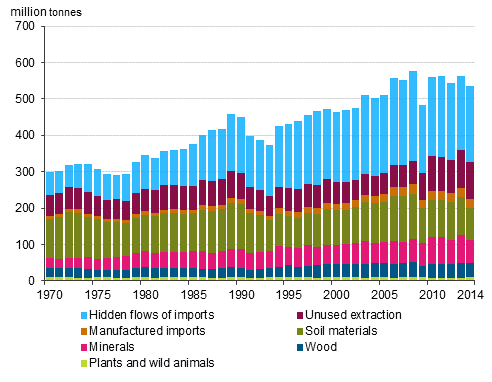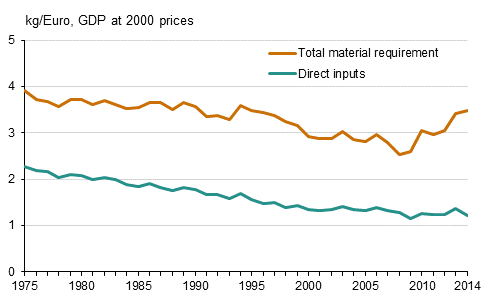Published: 19 November 2015
Soil extraction decreased in 2014
The extraction of sand, gravel and other stone from soil for building materials decreased by five to six per cent in 2014 from the previous year. The extraction of stone has fallen to 78 million tonnes, almost to the same level as in the deepest recession years of the 1990s, as shown by the statistics on economy-wide material flow accounts published by Statistics Finland.
Total material requirement by material groups in 1970 to 2014

Stone is used for the production of concrete and asphalt and for support and foundation structurers of buildings, roads and railways. Crushed rock has a share of nearly 60 per cent in total material requirement of stone. Stone has been replaced with waste material, such as scum, ash and crushed concrete, which may in part have diminished the need for stone.
Mines were quieter last year than in the previous one
The volume of quarrying in ore mines dropped by 16 per cent and the volume of ore even more than that, by over one third. In contrast, nearly the same volume of industrial minerals was recovered as in the year before. A total of 75 million tonnes of ore, useful stone and waste stone were extracted last year.
The bioeconomy has remained on level with the previous year
In all, 40 tonnes of wood were used as direct inputs, domestic and foreign ones combined. The figure in the early millennium was lowest in 2009, when the extraction of wood was 29 million tonnes, that is, around one quarter less than at the moment. Silage comes first in the extraction of plants and wild animals. Its annual material requirement is nearly two million tonnes. It is followed by cereal crops, barley, wheat and oat.
Finland is a material-intensive country
Each euro earned in Finland is tied to a material input of over one kg and to 3.5 kg of total extraction of natural resources. In the EU, the average material productivity is two to three-fold compared to Finland. Finland's figures of total extraction are particularly enlarged by the structure of our imports focusing on large items of raw materials and manufactured products, such as minerals, wood and building materials. Last year, the imported volume of raw materials was 33.7 million tonnes. Hidden flows of imports are very big.
Material intensity of Finland's economy in 1975 to 2014

Source: Economy-wide material flow accounts 2014, Statistics Finland
Inquiries: Simo Vahvelainen 029 551 3457, Leo Kolttola 029 551 3234, Jukka Muukkonen 029 551 3224, environmental.accounts@stat.fi
Director in charge: Ville Vertanen
Publication in pdf-format (212.1 kB)
- Tables
-
Tables in databases
Pick the data you need into tables, view the data as graphs, or download the data for your use.
Appendix tables
Updated 19.11.2015
Official Statistics of Finland (OSF):
Economy-wide material flow accounts [e-publication].
ISSN=2242-1289. 2014. Helsinki: Statistics Finland [referred: 9.12.2025].
Access method: http://stat.fi/til/kanma/2014/kanma_2014_2015-11-19_tie_001_en.html

